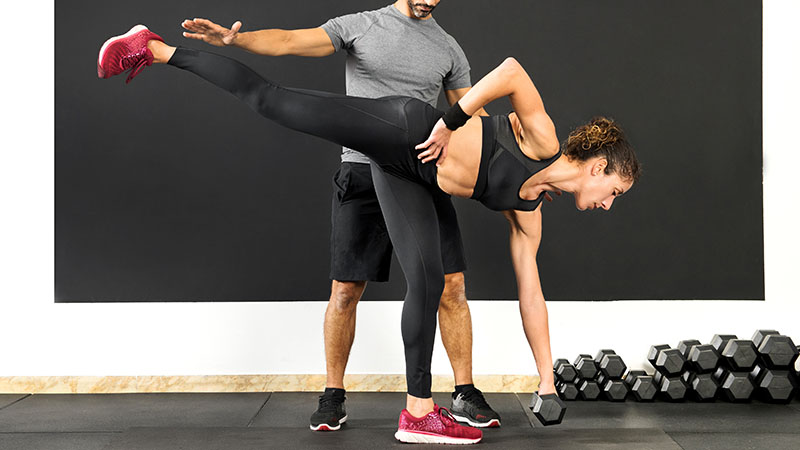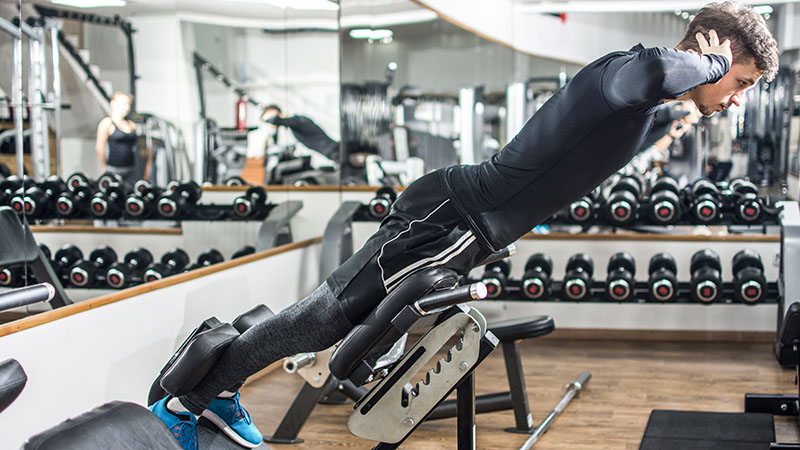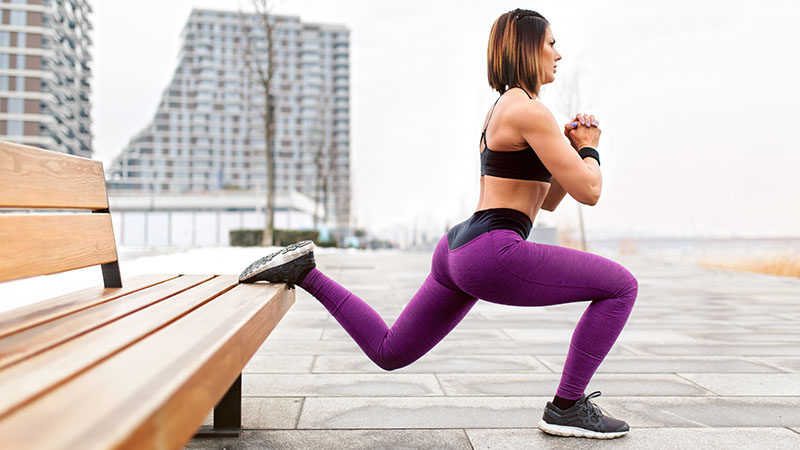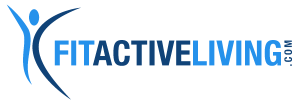Contents
- Hip Thrust Alternatives
- 1. Glute Bridge
- 2. Cable Pull Through
- 3. Kettlebell Swings
- 4. Straight Leg Deadlifts (barbell or dumbbells)
- 5. Smith Machine Donkey Kicks
- 6. Good Mornings
- 7. Single-Leg Romanian Deadlift (use a dumbbell or kettlebell)
- 8. 45-Degree Back Extensions
- 9. High Reverse Plank
- 10. Bulgarian Split Squat (use a barbell, dumbbell, or kettlebell)
- 11. High Step Ups
- 12. Monster Walk
Hip Thrust Alternatives
Hip thrusts are among one of the most popular exercises to help build size and strength in your glutes. Done with or without resistance, this exercise that targets the posterior chain, focusing mainly on the three gluteal muscles, plus the hamstrings, quads, hip adductors, and core helps to improve not only strength but stabilization, mobility, and athletic explosiveness. However, as with many exercises, it is important to have some variation, not only to halt the boredom but also to challenge your body, which leads us to explore hip thrust alternatives for your workout plan.
1. Glute Bridge
Steps
- Lying with your back flat on the floor, bend your knees so that your feet are flat on the ground
- Place your arms at your sides, palms facing down
- Raise your hips off the ground until your knees, hips, and shoulders are in a straight line
- Squeeze your glutes at the top of your lift and hold for a three-count before returning to the starting position
Muscles Worked
- Hip abductors (gluteus medius and minimus, tensor fascia lata)
- Hamstrings
- Quads
- Core
Benefits
The glute bridge, although relatively simple to execute, helps to improve hip mobility and strengthens your lower back
Exercise Tips
Focus on driving through with your hips. You should feel the work being done with your glutes and hamstrings
2. Cable Pull Through
Steps
- Using the double-sided rope handle, attach it to the cable machine on the lowest setting.
- Straddle the cable with your back towards the machine, holding one rope handle in each hand. Stand with your feet slightly wider than hip-width apart with a slight bend in your knees.
- Hinge forward at your hips, and keep a flat back with your arms extended straight down.
- As you stand upright, drive with your glutes and hamstrings, pulling the rope handles to approximately waist height, locking your hips, and squeezing your glutes.
- Slowly return to starting position as the cable pulls back through your legs.
Muscles Worked
- Gluteus maximus
- Hamstrings
- Erector Spinae
- Core
Benefits
A great posterior chain exercise, the cable pull-through is one of the great hip thrust alternatives that is lower back-friendly. When done properly, it is a perfect exercise for improving your hip hinge.
Exercise Tips
Be aware of how high you pull the cable. Believe it or not, there are stories of people injuring their nether regions by pulling too high or letting the rope slip through their hands.
3. Kettlebell Swings

Steps
- Standing with your feet shoulder-width apart, place the kettlebell on the floor in front of you between your feet
- With a slight bend in your knees, hinge forward at your hips, so your back is in a tabletop position
- Grab the kettlebell with an overhand grip
- Hike the kettlebell between your legs like you would a football and then, while driving your hips forward, raise the kettlebell with straight arms up to chest height.
- Allow gravity to swing the kettlebell back downwards and between your legs. Let your body swing with a similar motion, shifting your hips backward and your chest returning parallel with the ground.
- Continue using your hips and momentum to repeat the exercise.
Muscles Worked
- Glutes
- Hamstrings
- Spinal erectors
- Upper Back
- Core
- Forearms
- Latissimus Dorsi
- Deltoids
- Trapezius
Benefits
A great cardio and strength workout, kettlebell swings are one of the best hip thrust alternatives that help develop explosive power, as the exercise requires power from the hips and legs.
Exercise Tips
Do not use your shoulders during this exercise. Focus on power from the hips, core, and lower body.
4. Straight Leg Deadlifts (barbell or dumbbells)
Steps
- Standing with your feet hip-width apart with the loaded barbell on the floor in front of you.
- Hold the barbell with a neutral overhand grip, shoulder-width apart and your arms hanging straight down.
- With a very slight bend in your knees (yes, it goes against the whole straight leg name), hinge forward from your hips. Slowly stand up straight (do not lock your knees) and retract your shoulder blades, pulling the bar to approximately mid quad height.
- Slowly lower the bar straight down your legs, hinging at the hips. When the bar reaches the floor, drive back up using your glutes and hamstrings, extending through your hips into a standing position.
Muscles Worked
- Glutes
- Hamstrings
- Lats
- Calves
Benefits
By keeping your legs relatively straight (as noted, a slight bend is ok so your knees don’t lock), the straight leg deadlift will force you to lift from your hips, reinforcing a proper hip hinge and demanding flexible hamstrings.
Exercise Tips
Also known as the Stiff Leg Deadlift. Knowing your range of motion with your hamstrings is important in this hip thrust alternatives exercise. As you lower the bar, you will feel a good stretch in your hamstrings, which is expected. However, if you are not very flexible in your hamstrings, do not force yourself to lower the bar to the floor. You can either use blocks/weight plates to rest the bar on or just lower as far as you feel comfortable (Romanian Deadlift).
5. Smith Machine Donkey Kicks
Steps
- Set and secure the safety catch at the bottom position of the Smith machine, then place the bar on top.
- Place a folded towel or yoga mat under the Smith machine bar. Set yourself up in a tabletop position with your knees on the towel/mat.
- Lift one leg slightly to a 90-degree angle. Position the arch of one foot underneath the center of the bar.
- Using your foot, push the bar upward as far as you can, engaging your glutes.
- Slowly lower the bar to starting position and repeat for reps, then switch sides.
Muscles Worked
- Gluteus Maximus
- Gluteus Medius
- Core
Benefits
A great exercise for your rear end that will also challenge your core stability, as you will be in a three-point position (two hands, one knee).
Exercise Tips
Warm up with a set of donkey kicks with no resistance or use exercise bands to understand your range of motion and proper positioning.
A hip thrust alternative to using the Smith machine is simply using a resistance band.
6. Good Mornings
Steps
- Stand with your feet shoulder-width apart with a slight bend in your knees
- Position the weighted barbell on your shoulders so it rests on your trapezius muscles (upper back)
- Slowly hinge at your hips, pushing them backward, while your upper body leans forward until you are nearly parallel with the floor.
- With the same tempo, return to your starting standing position.
Muscles Worked
- Hamstrings
- Gluteus Maximus
- Adductor Magnus (inside thigh)
- Erector Spinae
- Obliques
- Rectus Abdominis
Benefits
Executing Good Morning exercises increases your leg and back strength as well as improve your hip extension and flexibility, which all help to improve your posture.
Exercise Tips
The depth of your hip hinge depends on your level of flexibility throughout your posterior chain. Although you may want to challenge yourself, extending past your level of flexibility will do more damage than good.
7. Single-Leg Romanian Deadlift (use a dumbbell or kettlebell)

Steps
- Holding the weight in one hand, stand on the opposite leg (weight right hand, stand on the left leg)
- With a slight bend in the standing leg, while keeping your back in a neutral position, hinge at your hips and lower your upper body until it is parallel with the floor
- You do not have to touch the ground with the weight. Pause slightly at the bottom before squeezing your glutes and thrusting your hips forward to raise your upper body back to starting position.
Muscles Worked (It may almost be easier to list the muscles not used as the Romanian Deadlift incorporates almost all the major muscle groups in your body)
- Glutes
- Hamstrings
- Lats
- Spinal Erectors
- Core
- Forearm flexors
- Calves
- Posterior Tibialis
Benefits
Single leg training is a functional method of exercise that allows you to work on mobility and strength imbalances. Often, we rely on our dominant side to jump, kick, or push. By focusing on one side of the body at a time, you take away any help from the dominant side.
Exercise Tips
If you are doing Romanian Deadlifts for the first time, try performing the exercise without weights and just focus on your balance and reach. For some, this is enough of a challenge.
8. 45-Degree Back Extensions

Steps
- You can do this exercise with or without weights (barbells, dumbbells, plates, or kettlebells).
- Using a back extension bench, adjust the leg pad so it is just below your waist, and place your feet flat against the blocks.
- Start in a prone position with your upper body aligned with your lower body (straight line from head to toe) Cross your arms in front of your chest, or clasp them behind your head
- Bend slowly at the waist and lower your upper body towards the floor. As you reach a 90-degree angle, return your body to an upright position.
- If you are advancing to using weights, you can hold the plate across your chest or when using the barbell, dumbbells, or kettlebells, let your arms hang straight down throughout the exercise. Do not use a heavy weight as you will do serious damage to your lower back.
Muscles Used
- Lower erector spinae
- Glutes
- Hamstrings
- Hip adductors
Benefits
A great exercise for beginners who struggle with proper execution of a deadlift or Good Morning exercises. The 45-degree back extension is also helpful for lower back pain, which is often associated with tight hamstrings and weak glutes.
Exercise Tips
Make sure not to overextend at the top of your motion. Often people will try to work their lower back more than they should. Stop when your back is in a straight line with your shoulders, hips, and feet. This is especially important if you are doing weighted back extensions.
9. High Reverse Plank
Steps
- Begin sitting on the floor/mat with your legs extended out in front of you.
- Place your hands, palms down, fingers spread wide, slightly behind you just outside of your hips
- Pressing into your palms, raise your hips and torso upward while keeping your arms and legs straight.
- Keep your toes pointed and look up at the ceiling
- Form a straight line from head to hips to heels. Squeeze your core.
- Hold for a set time (target 30 seconds)
- Slowly lower your hips and torso to the floor, back to the starting position. Repeat for reps as desired.
Muscles Worked
- Abdominals
- Hip flexors, adductors, and abductors
- Lumbar spine
- Glutes
- Hamstrings
Benefits
Besides working the glutes and hamstrings, the reverse plank provides an entire core workout that helps to improve posture and spinal stabilization.
Exercise Tips
Modifications to the high reverse plank include using your forearms or setting up in a reverse tabletop pose with both your hands and feet flat on the floor.
10. Bulgarian Split Squat (use a barbell, dumbbell, or kettlebell)

Steps
- Set one foot on a bench or box behind you. You can either lay the top of your foot flat, or position on your toes and the upper half of the bottom of your foot. Set your front foot in a proper squat position. You may have to hop around a bit to find the proper distance where you can perform a lunge movement.
- If you are doing this hip thrust alternative exercise with a barbell, place the weight across your back shoulders as you would a normal squat. If you are using dumbbells or kettlebells, you can hold them in each hand at your sides.
- Slowly squat down by bending your back leg towards the ground
- Keep your chest up and shoulders rolled back and down with a slight lean forward
- Use your front foot to drive back up to a standing position.
Muscles Worked
- Quads
- Hamstrings
- Glutes
- Calves
Benefits
Whereas a regular squat places the load of the weight on your lower back, the Bulgarian split squat puts the focus of the weight on your legs, not your back.
Exercise Tips
Make sure when you set your initial stance that you do not allow your knee to come over the top of your toes on your front foot when performing the squat/lunge movement.
11. High Step Ups
Steps
- Using a plyometric box or bench, place one foot on top
- Push through the top foot to lift your body up onto the box/bench
- Depending on your balance and strength, you can modify to add a knee drive with your opposite leg or just bring it to the top of the surface.
- Slowly step back down with the opposite foot first and then plant both feet on the floor. You can continue to work through a set with one foot first or alternate reps.
Muscles Worked
- Quadriceps
- Glutes
- Hamstrings
- Calves
- Core
Benefits
Another unilateral workout that allows you to focus on one leg at a time. As one of the simplest hip thrust alternatives, the step-up will draw attention to any lower body muscle imbalances.
Exercise Tips
The height of the box will target different muscles. A higher box will work your glutes more as hip flexion is increased. A lower box will focus more on your quads and calves. You can add dumbbells to your workout for added resistance.
12. Monster Walk
Steps
- Place a small resistance band around either your lower quad/thighs or just above your ankles
- Keep your feet approximately hip distance apart
- Clasp your hands together in front of your chest
- Settle into a quarter squat position with your hips pressed back. Engage your core and keep your upper body squared up.
- Take a wide step forward with one foot and then the other for a determined amount of steps.
Muscles Worked
- Hip Flexors
- Abductors
- Tensor fascia latae
- Glutes (medius and minimus)
Benefits
Increasing strength and mobility in the hips will help improve stability in day-to-day movements and also help prevent injury when doing other hip thrust alternatives like squats and deadlifts.
Exercise Tips
The further you place the resistance band from the lever (your hips), the more challenging the movement becomes.
Do not step at too wide of an angle as you will overstress your knees.
